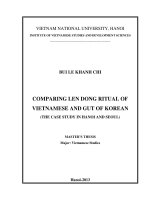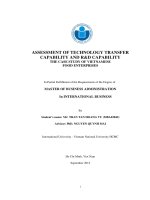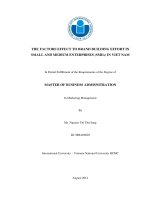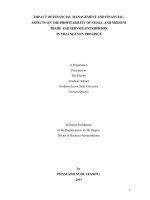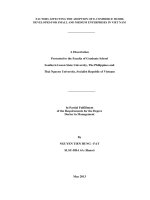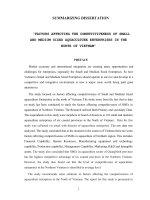THE PERCEPTION OF SMALL AND MEDIUMSIZED ENTERPRISES ABOUT THE TRANSPACIFIC PARTNERSHIP: THE CASE STUDY IN HANOI IN 2016
Bạn đang xem bản rút gọn của tài liệu. Xem và tải ngay bản đầy đủ của tài liệu tại đây (1.07 MB, 88 trang )
MINISTRY OF FOREIGN AFFAIRS
DIPLOMATIC ACADEMY OF VIETNAM
FACULTY OF INTERNATIONAL ECONOMICS
--------------------
BACHELOR’S THESIS
Student
: Nguyễn Văn Bảo
Class
: KT39A
Hanoi – 2016
MINISTRY OF FOREIGN AFFAIRS
DIPLOMATIC ACADEMY OF VIETNAM
FACULTY OF INTERNATIONAL ECONOMICS
--------------------
BACHELOR’S THESIS
THE PERCEPTION OF SMALL AND MEDIUM-SIZED
ENTERPRISES ABOUT THE TRANS-PACIFIC PARTNERSHIP:
THE CASE STUDY IN HANOI IN 2016
Supervisor
: M.A Nguyễn Thị Huyền
Student
: Nguyễn Văn Bảo
Class
: KT39A
Hanoi – 2016
ACCEPTANCE PAGE
I hereby state that I: Nguyễn Văn Bảo from class KT39A, Diplomatic
Academy of Vietnam, being a candidate for the degree of Bachelor of Arts
accept the requirements of the Diplomatic Academy of Vietnam relating to the
retention and use of Bachelor’s Graduation Paper deposited in the library.
In terms of these conditions, I agree that the origin of my paper deposited
in library should be accessible for the purposes of the study and research, in
accordance with the normal conditions established by the librarian of the care,
loan or reproduction of the paper.
Student
Nguyễn Văn Bảo
i
DISCLAIMER
I hereby declare that this graduation paper is my own original work and
has not been submitted before to any institution for assessment purposes.
Further, I have acknowledged all sources used and have cited them in the
reference section.
Student
Nguyễn Văn Bảo
ii
ACKNOWLEDGEMENTS
The writing of this graduation thesis has been a challenging but most
rewarding experience. This would not have been possible without the support of
many advisors, friends and family. First and foremost, I would like to express
my deepest gratitude to my primary advisor M.A Nguyen Thi Huyen for her
invaluable guidance and advice in the process of research and thesis
development. Her suggestions have enabled constant improvement and
refinement of the thesis and her encouragement has helped me brave the rough
time when things did not seem to go in the right direction.
I would also like to send my warmest thanks to the lecturers of Faculty of
International Economics at Diplomatic Academy of Vietnam, especially Assoc.
Prof. Dr. Dang Hoang Linh for bringing me the chance to write up the thesis and
for providing me with profuse valuable knowledge which is not only useful for
me in writing thesis but also certainly for my future career.
Getting through my thesis required more than academic support, and I
have many, many people to thank for helping me over the last few months.
Special thanks go to Mr. Van Nguyen, Vice Chairman of Hanoi Supporting
Industries Business Association, and M.A Ha Cong Anh Bao, Vice Dean of
Faculty of Law, Foreign Trade University. I cannot thank enough Jason Xu, my
best friend from Australia. He has been a great mentor and friend offering
patient advice and guidance throughout the research process.
I would like to send my special thanks to the Journalist for Commerce
Newspaper Ms. Nguyen Minh Thu and Ms. Do Duc Hanh for sharing with me
my worries, giving me their experience and guidance all along the way. I am
extremely thankful for all my friends, classmate, and six-mix band for always
being supportive, sharing and caring of me throughout the duration of the thesis.
iii
Many thanks to the interviewees of the company for taking time and
energy to participate in this study and in the interview, and to share valuable
information so generously.
Most of all, I would like to thank my family for the freedom, support and
love they have showered me with throughout these years, in both good times and
difficult times. They have given me the strength and courage to mount greater
heights and pursue my dreams, wherever they may be.
Student
Nguyễn Văn Bảo
Hanoi, May 2016
iv
ABSTRACT
With a desire to acquire a better understanding of international economic
integration, I have decided to investigate the perception of small and mediumsized enterprises about the Trans-Pacific Partnership. Existing literature has
provided a great deal of information related to the Trans-Pacific Partnership,
however, there remains a dearth of research concentrating on awareness of
enterprises, especially small and medium-sized ones. My research addresses
such literature gap by conducting a survey including in-depth interviews with
successful and reputable company leaders in Hanoi. Apart from these
interviews, quantitative and qualitative method are used to provide the empirical
results for my paper. My findings suggest that Vietnamese businesses should be
properly educated and fully aware of the Free Trade Agreements in the context
of globalization and international integration. Furthermore, businesses should
prepare well for intensive integration aimed at taking advantage of the
opportunities as well as overcoming any challenges. More broadly, these results
would be useful for businesses, the state agencies and policy makers.
Keywords: Perception, Trans-Pacific Partnership, Small and mediumsized enterprises, International economic integration.
v
TABLE OF CONTENTS
ACCEPTANCE PAGE ...................................................................................... i
DISCLAIMER ................................................................................................... ii
ACKNOWLEDGEMENTS ............................................................................. iii
ABSTRACT ....................................................................................................... v
LIST OF FIGURES .......................................................................................... x
LIST OF TABLES ............................................................................................ x
ABBREVIATIONS .......................................................................................... xi
CHAPTER 1: INTRODUCTION………… .................................................... 1
1.1 Concept of Economic Integration ............................................................ 2
1.2 Significant of the study ............................................................................. 3
1.3 Research problem: The perception of small and medium-sized
enterprises about the Trans-Pacific Partnership ................................................ 6
1.4 Contribution of the study ......................................................................... 7
1.4.1 Theoretical and methodological contributions..................................... 7
1.4.2 Practical contributions .......................................................................... 7
1.5 Research questions .................................................................................... 8
1.6 Structure of the study ............................................................................... 8
CHAPTER 2: LITERATURE REVIEW .......................................................... 9
2.1 An overall picture on Vietnam’s small and medium-sized enterprises9
2.2 The Trans-Pacific Partnership and its highlighted features ............... 12
2.3 The Tran-Pacific Partnership’s commitments in relation to small and
medium-sized enterprises ............................................................................. 14
vi
2.4 The empirical research on the perception of the enterprise about
international integration ............................................................................... 15
2.4.1 The ASEAN Economic Community: A Work in Progress................ 15
2.4.2 The awareness of Vietnamese enterprises about international
economic integration .................................................................................. 17
2.4.3 The Vietnam Provincial Competitiveness Index 2014 and the
Vietnam Provincial Competitiveness Index 2015 ....................................... 19
Conclusions for Chapter 2 ............................................................................. 22
CHAPTER 3: RESEARCH METHODOLOGY ........................................... 23
3.1 Research design ....................................................................................... 23
3.1.1 Research site ....................................................................................... 23
3.1.2 Time frame ......................................................................................... 23
3.1.3 Objects of study .................................................................................. 24
3.1.4 Sample and Sampling technique ....................................................... 24
3.1.5 Data collection.................................................................................... 25
3.1.5.1 Primary Data collection ................................................................. 25
3.1.5.2 Secondary Data collection .............................................................. 26
3.1.6 Methods of data analysis and presentation of results ……..……. ... 26
3.2 Hypotheses of the study ......................................................................... 27
3.3 Limitations of study ................................................................................ 27
Conclusion for chapter 3 ............................................................................... 29
CHAPTER 4: DATA ANALYSIS AND INTERPRETATION .................... 30
4.1 Sample features ....................................................................................... 30
4.1.1 Position of the interviewee ................................................................. 30
4.1.2 Economic sector ................................................................................. 31
vii
4.1.3 Business scale..................................................................................... 31
4.1.4 The main market................................................................................. 32
4.2 The general perception about the Trans-Pacific Partnership ............ 33
4.2.1 The interest level in the Trans-Pacific Partnership ............................ 33
4.2.2 Understanding of businesses on specific terms in the Trans-Pacific
Partnership ................................................................................................... 35
4.2.3 Understanding of businesses on chapter for small and medium-sized
enterprises.................................................................................................... 36
4.2.4 Impact of the Trans-Pacific Partnership............................................. 37
4.2.5 Preparation for the Trans-Pacific Partnership .................................... 38
4.2.6 Change in company‟s business strategy............................................. 39
4.2.7 Readiness for the integration .............................................................. 40
4.3 The specific perception of small and medium-sized about the TransPacific Partnership ........................................................................................ 40
4.3.1 The negotiation process of the Trans-Pacific Partnership ................. 40
4.3.2 The official signing of the Trans-Pacific Partnership ........................ 41
4.3.3 The most interested content ............................................................... 42
4.3.4 Preparation for the Trans-Pacific Partnership .................................... 43
4.3.5 The opportunities and challenges ....................................................... 43
4.4 The factor affecting the awareness of the small and medium-sized on
the Trans-Pacific Partnership ...................................................................... 44
Conclusions for Chapter 4 ............................................................................ 48
CHAPTER 5: CONCLUSIONS AND RECOMMENDATIONS ................. 49
5.1 Conclusions .............................................................................................. 49
5.2 Hypothesis testing.................................................................................... 51
5.3 Recommendations ................................................................................... 51
viii
5.3.1 Recommendations for enterprises ...................................................... 52
5.3.2 Recommendations for professional associations ............................... 52
5.3.2 Recommendations for policy makers ................................................. 53
5.4 Suggestions for future work ............................................................... 53
APPENDICES ................................................................................................... 54
The Appendix 1 (for in-depth interviews): The perception of small and
medium-sized enterprises about the Trans-Pacific Partnership: the case
study in Hanoi in 2016 .................................................................................. 55
The Appendix 2 (for questionnaires – Vietnamese version) ..................... 59
The Appendix 3 (for questionnaires – English version) ............................ 66
REFERENCES .................................................................................................. 73
ix
LIST OF FIGURES
Figure 4.1 - Number of interviewees by title ..................................................... 30
Figure 4.2 - Number of enterprises by economic sector .................................... 31
Figure 4.3 - Number of enterprises by labor scale ............................................. 32
Figure 4.4 - Number of enterprises by main market .......................................... 33
Figure 4.5 - The interest level in the TPP .......................................................... 34
Figure 4.6 - The basic understanding of business on specific terms ................. 35
Figure 4.7 - The basic understanding of business on chapter for SMEs ............ 36
Figure 4.8 - The impact of the TPP .................................................................... 37
Figure 4.9 - The number of firms prepares to join the TPP ............................... 38
Figure 4.10 - Change in company‟s business strategy ....................................... 39
Figure 4.11 – Readiness for the integration ....................................................... 40
Figure 4.12 - The year Vietnam joins the negotiation ....................................... 41
Figure 4.13 - The year the TPP officially signed ............................................... 41
Figure 4.14 - The most interested content in the TPP ........................................ 42
Figure 4.15 - The factor affecting the firms „awareness on the TPP ................. 44
LIST OF TABLES
Table 1.1 - Vietnam‟s FTAs and their status ....................................................... 4
Table 2.1 - Classification of enterprises in Vietnam .......................................... 10
Table 2.2 - The number of SMEs by labor in Vietnam in 2014 ......................... 11
Table 2.3 - The number of SMEs by capital in 2014 .......................................... 11
x
ABBREVIATIONS
ASEAN
Association of Southeast Asian Nations
AEC
ASEAN Economic Community
CEO
Chief Executive Officer
C/O
Certificate of Origin
EU
European Union
FIEs
Foreign-invested Enterprises
FTAs
Free Trade Agreements
IRED
Institute for Research on Educational Development
ISEAS
Institute of Southeast Asian Studies
MOIT
Ministry of Industry and Trade
OECD
Organization for Economic Cooperation and Development
PCI
Provincial Competitiveness Index
RCEP
Regional Comprehensive Economic Partnership
SMEs
Small and Medium-sized Enterprises
SOEs
State-owned Enterprises
TPP
Trans-Pacific Partnership
WTO
World Trade Organization
VCCI
Vietnam Chamber of Commerce and Industry
VND
Vietnamese Dong
xi
CHAPTER 1: INTRODUCTION
At the University, we have been provided wide knowledge on free trade
agreements (FTAs), including the Trans-Pacific Partnership (TPP). Although at
that moment, the TPP was still being negotiated in secret, the author understands
that the TPP is a comprehensive trade deal that focuses on a smaller group of
countries than that of the World Trade Organization (WTO).
From many articles written by both Vietnamese and foreign economists
on the impacts of the TPP on its member countries, an overwhelming majority
of economists believe that Vietnam is likely to be the biggest winner of the
Trans-Pacific Partnership1. Meanwhile, some doubt the potential success of this
trade agreement when compared to the WTO. Furthermore, new challenges are
present in sectors like agriculture and pharmacy.
Being motivated to give a new stance about the TPP, the author thus tries
to answer the question: “What are the perceptions and opinions of small and
medium-sized enterprises (SMEs) about the TPP?” and also come up with a
number of suggestions to help SMEs have more understanding and raise their
awareness about the TPP to prepare adequately for international economic
integration. Specifically, this study aims to:
(1)
Provide key features that define the TPP as a landmark 21st-century
agreement.
(2)
Give an overview of SMEs in Vietnam, as well as TPP‟s
commitments in relation to SMEs.
(3)
Provide an overview of empirical studies on raising awareness for
Vietnamese businesses on international economic integration with FTAs.
1
John Boudreau, The Biggest Winner From TPP Trade Deal May Be Vietnam, bloomberg,
last accessed on March 06th, 2016.
1
(4)
Point out the status quo of SMEs‟ perception about the TPP. Through
the results of an interview with the managers of SMEs in Hanoi about their
opinion and understanding towards the TPP, the author will conduct an
assessment about this situation and come up with a number of recommendations
for raising the perception of SMEs about the TPP and international economic
integration.
1.1 Concept of Economic Integration
According to Miroslav N. Jovanovic, Economic Integration is defined as a
process and a means by which a group of countries strives to increase its level of
welfare2. After World War II, several international organizations were
established to promote international economic cooperation, such as the
Organization for Economic Cooperation and Development (OECD), the Council
for Mutual Economic Assistance, the European Economic Community.
However, since the 1990s, this process has developed significantly with the
establishment of various regional and global economic organizations. Most
countries in the world have been actively engaged in this process.
In the past, the concept of Economic Integration has meant purely tariff
reduction or expanding the market. For example, during the seven rounds, from
Geneva round (1947) to the Tokyo round (1973-1979) of the General
Agreement on Tariffs and Trade focused only on tariff reductions. Currently,
there are two concepts of economic integration, including regional economic
integration (such as The North American Free Trade Agreement, European
Union) and global economic integration (WTO). The concept of regional
economic integration implies that nations of a geographic region come together
in some type of partnership to foster trade and development3. Regional
economic integration can be manifested as a free trade area, a customs union, a
2
Miroslav N. Jovanovic (2006), The Economics of International Integration, Edward Elgar Publishing.
William J. Kehoe, Regional and global economic integration: implications for global business,
/>isposition=0&alloworigin=1, last accessed on March 19th, 2016.
3
2
common market, a monetary union, or in its most extreme form, as an economic
union4. The concept of global economic integration implies the WTO where is
the only global international organization dealing with the rules of trade between
nations5.
1.2 Significance of the study
The year of 2015 marked a watershed year for Vietnam in the process of
international economic integration with the negotiations of EU - Vietnam Free
Trade Agreement, and the conclusion of the TPP. Another highlight was the
official launch of ASEAN Economic Community (AEC) on December 31st,
2015. Along with the bilateral and multilateral FTAs which Vietnam has signed,
these FTAs have promoted deeper and more comprehensive international
economic integration.
In this context, the aim is to take advantage of the opportunities as well as
to overcome the challenges. Vietnam‟s business community, especially SMEs,
should be properly educated and fully aware of the international economic
integration. The negative impacts of the world crisis and weaknesses during the
post-WTO period gave the warning signs for Vietnam‟s enterprises that they
should not be subjective with the seemingly promising TPP. The table below
describes the FTAs that Vietnam joins and its status.
4
Do Duc Binh, Ngo Thi Tuyet Mai (2012), Giáo trình Kinh tế quốc tế, National Economic University
Publishing House, Hanoi.
5
What is the WTO, WTO,
last accessed on March 19th,2016.
3
Table 1.1: Vietnam’s FTAs and their status
Name
Status
1.
ASEAN - China Free Trade Agreement
Effective
2.
ASEAN - Korea Free Trade Agreement
Effective
3.
ASEAN – Japan Comprehensive Economic
Effective
Partnership
4.
ASEAN – Australia – New Zealand Free Trade
Effective
Agreement
5.
ASEAN-India Free Trade Agreement
Effective
6.
Vietnam – Japan Economic Partnership
Effective
Agreement
7.
Vietnam – Chile Free Trade Agreement
Effective
8.
Vietnam – Korea Free Trade Agreement
Effective
9.
Trans-Pacific Partnership Agreement
Signed
on
4th
February 2016
10.
Vietnam – Eurasian Economic Union Free Trade Signed on 29th May
Agreement
2015,
pending
ratification
11.
EU – Vietnam Free Trade Agreement
Negotiation
concluded
on
4th
August 2015
12.
Regional Comprehensive Economic Partnership
Negotiating
13.
ASEAN – Hong Kong Free Trade Agreement
Negotiating
14.
Vietnam – Israel Free Trade Agreement
Negotiating
15.
Vietnam - EU Free Trade Agreement
Negotiating
Source: Compilation from the WTO Center as of April, 2016
4
Among the FTAs above, the TPP is an increasing importance of
Vietnam‟s economy for a number of reasons. To begin with, as TPP member
countries account for 39% of Vietnam‟s total exports in 2014, deeper integration
with
these
economies
will
enhance
Vietnam‟s
export
performance6.
Furthermore, a greater inflow of foreign direct investment may be another
healthy impact of the TPP on the country‟s long-term economic prospects7. The
TPP was finally signed on February 4th, 2016.
According to New Zealand Prime Minister John Key, however, the
signing is an important step but the agreement is still just a piece of paper, or
rather over 16,000 pieces of paper until it actually comes into force8. In fact, the
TPP is a controversial issue in many countries. There is a strong opposition to
the TPP‟s opponents in the United States, Malaysia, and other countries.
According to Ms. Hillary Clinton, she was worried this agreement would not do
enough to crack down on currency manipulation or protect consumers from
excessively high drug prices9. In Malaysia, thousands of Malaysians protested
against plans to join the TPP because they feared that their country could lose
control of its economy. Critics also argued that SMEs - providing 65 percent of
jobs - will be among the worst hit if the trade deal were to take effect10.
The research is therefore theoretically significant in its contribution to the
investigation of the opinions and perceptions of SMEs about economic
integration, especially the TPP‟s integration. By conducting interviews related to
the perception of SMEs about the TPP, this graduation thesis contributes to the
understanding of a business community in the process of international
integration.
6.7
Le Hong Hiep, The TPP‟s Impact on Vietnam: A Preliminary Assessment, SEAS Perspective, No. 63 Issue.
2015, 04/11/2015.
8
Rebecca Howard, Trans-Pacific Partnership trade deal signed, but years of negotiations still to come, reuters,
last accessed on March 10th, 2016.
9
'The risks are too high': Hillary Clinton in U-turn as she opposes new Trans-Pacific Pact,
last accessed on
May 1st, 2016.
10
Joseph Sipalan, Protesters hit the streets to oppose Malaysia signing TPP, reuters,
, last accessed on May 1st, 2016.
5
Hence, the thesis addresses a gap from other studies: a lack of research
concentrating on the perception of SMEs about the TPP, with a case study of
SMEs in Hanoi.
1.3 Research problem: The perception of SMEs about the TPP
Although the policy has made a remarkable progress, the lack of
perception on economic integration before and after the signing of trade
agreements is extraordinarily prevalent. Throughout the years, on the mass
communications, a number of organizations and individuals has given diverse
judgements about the perception integration of Vietnamese businesses. For
example, in 2013, Institute of Southeast Asian Studies in Singapore (ISEAS)
conducted a survey about “The ASEAN Economic Community: A Work in
Progress”11, relating to the content of the AEC as tariff barriers, services,
intellectual property, etc. “ASEAN Economic Community Business Survey”
mentioned ASEAN business firms‟ awareness of or interest in the AEC. In the
Vietnam Provincial Competitiveness Index (PCI) 2014 and PCI 2015 presented
foreign and domestic perceptions of the TPP. In the late 2015, PACE Institute of
Management had announced the results of a survey in the context of concluded
negotiations for the TPP and the AEC will be established. Besides this, there are
a number of surveys carried out by professional associations. According to the
report of Hanoi Business Association, 80% of firms were not aware of or
interested in integration12. However, there is a lack of detailed research on the
perception of Vietnamese enterprises, especially SMEs about international
integration, although the process of regional and international integration has
taken place decades ago.
11
Sanchita Basu Das, Jayant Menon, Rodolfo C Severino, Omkar Lal Shrestha (2013), The ASEAN Economic
Community: A Work in Progress, Institute of Southeast Asian Studies and Asian Development Bank.
12
Anh Phuong, Doanh nghiệp Việt hụt hơi trong hội nhập, The voice of Vietnam, last accessed on April, 9th 2016.
6
In this study, the author chose to conduct this research at a micro level
among SMEs managers who are working in Hanoi because for a demonstration
of findings for the gap of recent studies in Vietnam and suggest suitable research
subjects and approaches for later studies, programs, and projects in this field,
which is the perception of SMEs about the TPP.
1.4 Contribution of the study
1.4.1 Theoretical and methodological contributions
Academically, some studies have been conducted on awareness of
enterprises about the TPP, WTO, and the AEC. However, there is hardly any
study or investigation on the perception of enterprises, particularly SMEs about
the TPP at both national and international levels in Vietnam. Hence, this
graduation thesis wishes to fulfill this shortage in the research about SMEs in
the case of Hanoi and infers it to Vietnam‟s context.
Methodologically, apart from the desk studies of all the documents
relating to the domain and the theme, a survey was conducted among the SMEs
in Ha Noi with a designed questionnaire that was easy to the SMEs to fill in and
also some in-depth interviews carried to supplement the information. The result
of the research survey serves as a primary data of the perspective and awareness
of SMEs about the TPP and secondary sources for any other studies related to
this topic.
1.4.2 Practical contributions
In terms of individuals, this study will help SMEs realize the importance
and necessity to understand about the TPP in order to help enterprises prepare
and improve at developing their firms in the face of the opportunities and
challenges of regional and global of international economic integration. In
addition to this, this study also gives some solutions to help enterprises become
active in the process of implementing the TPP.
7
In the broader sense, this study suggests a new direction for other
studies about the TPP, and even for programs and projects of the Vietnamese
government. Other studies and projects in Vietnam should extent their research
subject to the perception raising for SMEs about the TPP.
1.5 Research questions
The focus of the study lies in the assessment the perception of SMEs
about the TPP, and the integration. Thus, this study expects to find out the
answers to the following questions:
1. How are the perceptions of SMEs about the TPP?
2. What are the factors that affect how SMEs are perceived in
Vietnam?
1.6 Structure of the study
This graduation paper is divided into five chapters:
Chapter 1 (Introduction): Introduce the concept of economic integration,
significance of the study, research problem, objectives, contribution, research
questions, and the structure of the study.
Chapter 2 (Literature review): Provide an overall picture on Vietnam‟s
SMEs, key features of the TPP, and a comprehensive review of studies
conducted in both foreign countries and Vietnam.
Chapter 3 (Research methodology): Elaborate on the research design
followed in this study, hypotheses set for the study and limitations of the study.
Chapter 4 (Data analysis and interpretation): Illustrate the results of the
analysis done on the survey taken up through the questionnaire and in-depth
interviews and their interpretation thereof.
Chapter 5 (Conclusions and recommendations): Consist of conclusions
and recommendations of the study for enterprises, professional associations, and
policy makers. This chapter ends with some suggestions for further studies.
8
CHAPTER 2: LITERATURE REVIEW
It is essential to go through and review the literature available in the
domain of the research study. This chapter starts with the definition of SMEs
and some highlighted features of the TPP. Several studies have been undertaken
to understand the awareness of enterprises and its implications in international
economic integration. This chapter also presents the review of empirical results
of available studies.
2.1 An overall picture on Vietnam’s small and medium-sized enterprises
SMEs have been defined in various ways. It depends on the levels of
development of a country, profession or classified business purposes in
particular periods. However, the most commonly used criterion is the number of
employees in the enterprise. The EU and a large number of OECD, transition
and developing countries set the upper limit of number of employees in the
SMEs between 200-250, with a few exceptions such as Japan (300 employees)
and the USA (500 employees)13.
In this chapter, the concept of SMEs is defined and discussed according to
the Government‟s Decree No.56/2009/ND-CP dated 30/6/2009 on assistance to
the development of SMEs.
As stipulated in this Decree, Vietnamese enterprises are classified into 4
group according to labor size, capital size, and economic sectors, specifically
including micro, small, medium and large enterprises as described in Table 2.1
13
OECD (2004), Promoting SMEs for development: The Enabling Environment and Trade and Investment
Capacity Building.
9
Table 2.1 - Classification of enterprises in Vietnam14
Sector
Micro-sized
Small-sized
Medium-sized
enterprises
enterprises
enterprises
Labor
Labor
Capital
Labor
Capital
Over 20 to
Agriculture,
forestry,
≤ 10
11-200
≤ 20
201-300
VND 100
and fishery
persons
persons
billion
persons
billion
Over 20 to
Industrial
and
≤ 10
11-200
≤ 20
201-300
VND 100
construction
persons
persons
billion
persons
billion
Over 10 to
Trade and
services
≤10
11-50
≤ 10
51-100
VND 50
persons
persons
billion
persons
billion
From the above table, a SME is defined as an enterprise of agriculture,
forestry, fishery and manufacture that employs less than or equal to 300 persons
with a capital of less than or equal to VND 100 billion, while all other
businesses employ less than or equal to 100 persons with a capital of less than or
equal to VND 50 billion. The tables below show the number of enterprises by
labor and capital in 2014.
14
Decree No.56/2009/ND-CP dated 30/6/2009 on assistance to the development of SMEs.
10
Table 2.2: The number of SMEs by labor in Vietnam in 2014
Quantity
Micro
Small
Medium
Large
Total
287,595
99,003
7,300
8,323
402,251
71.50
24.61
1.82
2.07
100
(of
enterprise)
Proportions
Source: Vietnam business annual report 2015
Table 2.3: The number of SMEs by capital in 2014
Quantity
Small
Medium
Large
Total
308,499
71,997
21,755
402,251
76,69
17.90
5.41
100
(of
enterprise)
Proportions
Source: Vietnam business annual report 2015
Obviously, a great number of enterprises in Vietnam are SMEs,
accounting for over 97% of all enterprises. It is undeniable that SMEs play a key
role in Vietnam‟s economy. The development of SMEs would contribute
strongly to the socio-economic development in Vietnam, such as job creation,
poverty alleviation, and promotion of equitable distribution of wealth.
According to the statistics, SMEs contribute to 50% of GDP, 33% of state
budget revenues, 62% creating jobs for employees, contributing 49% to creating
added value for the economy in 201515. However, SMEs have been confronted
with many problems, including low skills, low levels of education, poor product
quality, lack of finance and other issues. In addition, an increasing number of
businesses go bankrupt. In 2015, the number of business dissolutions or
15
Duy Phuong, Doanh nghiệp vừa và nhỏ - Mạnh về lượng, yếu về chất, Chứng khoán Tân Việt,
,
last accessed on March 21st, 2016.
11
shutdowns reached over 80 thousand, of which 9,641 enterprises have disclosed
and 71,391 enterprises have shut down16 (mainly SMEs). Furthermore,
according to the PCI 2015, the market share of SMEs is mostly domestic even
after nearly ten years following Vietnam‟s integration into the WTO 17 (only 3%
of micro-sized, 4% of small-sized and 9% of medium-sized firms have their
customers that are foreign individuals or enterprises).
2.2 The Trans-Pacific Partnership and its highlighted features
The TPP, which is one of the world's biggest multinational trade deals,
was signed by 12 member nations - Australia, Brunei Darussalam, Canada,
Chile, Japan, Malaysia, Mexico, New Zealand, Peru, Singapore, United States,
and Vietnam - on Thursday February 4th, 2016 in New Zealand, but the massive
trade agreement will undergo a two- years ratification period before it comes
into force. The TPP would promote more open trade, greater economic
opportunity, and higher standards in 12 countries accounting for almost 40
percent of the global economy18.
Through the TPP, the member countries pursue liberalized trade and
investment and establish new rules and disciplines in the region beyond what
exists in the WTO. The TPP contains 30 chapters. Although it is called a “trade”
agreement, the TPP is not mainly about trade. Apart from updating traditional
trade issues covered by previous FTAs (goods, services), the TPP also focuses
on emerging trade issues (state-owned enterprises (SOEs), government
procurement), cross-cutting issues (the environment, labor), and other topics.
16
Pham Thi Thu Hang, Vu Tien Loc (2016), Vietnam Business Annual Report 2015, Information and
Communications Publishing House, Hanoi.
17
Edmund Malesky (2015), The Vietnam Provincial Competitiveness Index, Labour Publishing House, Hanoi.
18
Daniel Halper, Obama: Trade Deal '40 Percent of the Global Economy', weeklystandard,
last
accessed on March 15th, 2016.
12




